KNOWLEDGE, CULTURE AND COPYRIGHT
By Coral Hull
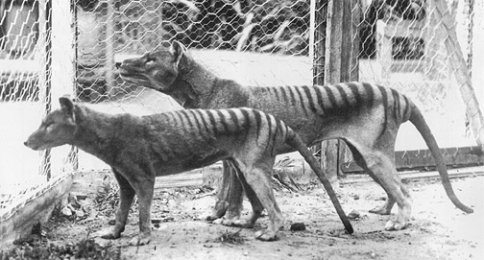
Thylacinus cynocephalus - "The pouched dog with the wolf's head".
Welcome to the eleventh issue of Thylazine; The Australian Journal of Arts, Ethics & Literature.
One knowledge, one consciousness. Who can claim to own it? What gives us the ultimate right to ownership and thereby control over physical matter and the information that presents itself through our connection to it?
Do I own myself - do I possess and copyright the body that I exist in? When someone takes a photograph of me, do they then lay claim to be the owner of my image, the way in which I smiled, the hairstyle that was created, the soul behind my eyes, the clothes that I purchased, the building that I stood in front of, that an architect designed? Who owns these images and to which consciousness do we seek permission, in order to have control over them - myself, my parents, their parents, the hairdresser, the photographer, the building or the architect?
Whoever desires to own copyright attempts and ultimately fails in controlling the access to and the free flow of consciousness around them. This consciousness is what makes up a multitude of realities: information, culture and ideas. While copyright can exist as an idea supporting and promoting control over another idea, it cannot occur in a universal existance, where the movement and flow of consciousness is part of the creative process. Consciousness continues whether we choose to attempt to exert control over it or not. In order for us to be co-creators, we need to realise that we are not working in isolation from each other or from anything around us.

|
So who decides who owns or exerts control over matter and who does not? For example: If a brick fell from a building due to a freak gust of wind, created by atmospheric changes, landing onto the button of a camera, thereby allowing that camera to take a photo of the side of that building, then who would own copyright? The brick? The building? The architect who designed the building? The builder? The gust of wind? The sky that the wind came from? The rotation of the planet that caused the wind to blow? The camera that took the photo or the creator of the camera or neither? |
The simple answer is, that it would be "the owner" of camera that took the photo, who would have legal claim over the photo image of the building. This would be the case, even if the owner of the camera was not present at the time that the photo was taken. Therefore it would not be the creator of the camera, nor the creator of photographic artwork who owned this image, since copyright is not about creation, it is about exerting control over creation. Therefore it is not "the creator" or "the creators" of the image, but "the owner" whose material and financial interest is now best served, since copyright is about ownership and not creativity or creators.
The idea of ownership and material aquisition is the current preoccupation of many human beings. It has little to do with the creative process and more to do with continually attempting to exert power over time and matter - past, present and future. Therefore the issue, in this case, is not one of the justice of creators being paid for their work, since there may be many creators involved, but of who will claim the ultimate control over the information that is created by many and will now be 'owned' by a few, in order that they profit from that ownership. Those who seek to control are more than likely those who create the laws and those who will eventually, even if for a brief time, be allowed to exert that control. The pathology of power and control is fear.
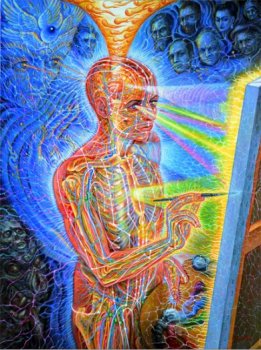
|
As creative practitioners we are not working and thinking in isolation, each from the other. When we create, we are tapping into a vast storehouse of knowledge and information that involves our physical and conceptual environment. Our own creations are built upon the ideas of a multitude of consciousnesses that we perpetually access and turn into matter. As co-creators we have access to and therefore utilise all the knowledge that ever existed in the universe and, as this knowledge is brought into our awareness, it becomes our gift that we rejoice in through expression or creativity.
As co-creators we are part of a self-creating universe. We are each recreating that which already exists, that which has existed and will exist. As co-creators, we are thought to ulitise our environment and channel information; whereby our consciousness becomes a process of interlinking and uncensored conscious creation. Only fear fueled by a lack of awareness restricts access to this information by the attempt to possess and control that which is free flowing, expansive. |
In human society ownership relies upon the exchange of money and so the wealthy own the information and copyright laws simply become a means by which they do so. Copyright is the legal certificate of ownership over information.Copyright protects nobody except those fearful narcissistic and sociopathic aspects of our egos, that drive us to attempt to exert power over our surroundings, at least in a temporary and illusory way.
The Narcissistic Ego As Poet
A poet demanded that several of his poems, that had been quoted by a writer referring to his work in an article, be removed from a previous issue of Thylazine. He then demanded that the article about his work be removed as well. He then began to access email addresses from the directory in order to spread misinformation in an attempt to destroy my credibility as a publisher. Despite being legally in the wrong, he then sought a lawyer who began harrassment via email. He then had the lawyer send a letter demanding hundreds of dollars from The Thylazine Foundation. I assumed by this stage that it was money he was after. The fact was that the poems had been quoted as part of an article examining his work in a positive way by a writer, in a journal that pays contributors and is free to the public, with cited work being acceptable under law. This poet was therefore both morally and legally out of line. The outcome of this 'storm in a teacup' was that the lawyer faded away and all the previous issues of Thylazine remained intact and archived to be read and enjoyed by future generations.
This is a small incident amongst many that can and do occur in the publishing world. However, on its own it provides both an example and a reminder, of how the idea of 'copyright' and 'ownership' of conscious creations, can so easily be exploited by those who desire the power to restrict access to information. This incident was about anger and the lust for money. The idea of exerting control and ownership over information and culture simply fed this state of mind. Any control will ultimately fail, since creativity is transformative and expansive.
The Exploitation of Copyright Laws
The next incident that I will refer to involves two publishers of Australian poetry - Salt Publishing and Paperbark Press. Both publishers are selling my books illegally and are pocketing the funds that are meant to be assisting children and animals. The exploitation of the disabled and differently-abled by narcissists and sociopaths is old news in this society, that many people who are numbed to injustice would have grown accustomed to by now.
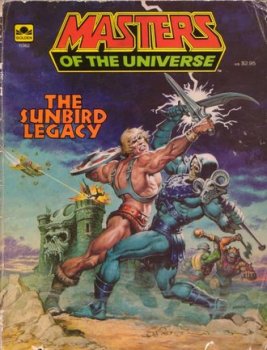
|
But this time something different and entirely unexpected occurred in my own mind as a result of this situation. That being, that the discomfort that I was experiencing came not as a result of being the victim, but as a direct consequence of my participation in a reality that had so often bewildered me and that I had no interest or belief in. As a result of this initial awareness, I began to observe myself in the act of attempting to extert control over work (in this case two books of poetry titled Bestiary and Zoo) that I had co-created in conjunction with the universe.
Since I was legally in the right, The Australian Society of Authors assisted me by writing to both publishers on my behalf. They were predictably ignored. I was then placed in contact with lawyers in Sydney through The Australian Copyright Council in order to initiate legal proceedings. But something wasn't right and as this filtered through into my awareness and understanding, I realised that I had been a participant in a reality that I did not believe in in the first place. Furthermore, this attempt to exert control over something that the universe had assisted me in creating, was not good for my own creative or spiritual development. |
The elite powers that initiate these laws also allow them to be broken when it suits their own agenda. These publishers are both funded, endorsed and protected by The Literature Board (Australian Government) and the legal system that protects the interests of the wealthy. The system that creates the laws is the same system that allows them to break the laws. If I attempted to exert control over creation, I would be operating on their terms, therefore I would be the same as them, but without the money or the belief. I was finally able to see my own role in the game of the narcissists. Was I now going to participate in a reality that I had no belief in?
My decision ended up being based on where I might best assist human society and by my ongoing awareness of a single universal consciousness. Therefore, I preferred to spend my money paying creative contributors for the inclusion of their work in Thylazine, feeding children and saving the lives of animals rather than perpetuating a destructive reality based on fear and control. This proved to be a valuable lesson alongside many others in my creative career. These experiences had provided a very real awakening into my own belief of exerting control over one's environment by attempting to claim ownership and copyright over my role in the creative process.
In both cases, in so far as this society who created these laws was concerned, it did not matter who was legally in the wrong or right, only how much money they had in order to exert and maintain control and to utilise the legal system for a self-centred purpose. Furthermore, copyright laws had little to do with protecting the rights of the creator and more to do with who had the most societal knowledge, in order to exploit such laws to their own advantage, in an attempt to continue to exert control over their physical surroundings. Create a sense of property and ownership and you already have a thief. Criminals such as these cannot exist in a reality where there is no concept of ownership. By participation in the game I was playing a part in the creation of the crime.
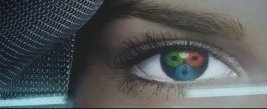 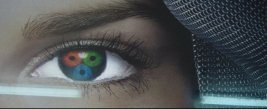
One Consciousness, One Knowledge
While copyright masquerades as a moral issue, it is more often than not an attempt to exert control over our physical surroundings, in order to alleviate our fears of that which we cannot control, through unrealistic claims of ownership over a universe in transformation. By our participation, we attempt to make money from and insist on power over what we think we own and thereby create the temporary illusion of personal security.
When we create we are tapping into a universal consciousness and knowledge that connects us to each other. Creativity is an ongoing expansive unstable process. To bring even some of this consciousness into a physical state is a sacred occupation. To attempt to exert control over that creative process is where the contraction of an immaterial expansive state begins. For some, this results in fear-based hatred as they attack what they are unable to control. For others, like poets who no-body knows about or reads, the insistance of 'ownership' proves to be little more than another form of restriction placed upon the work, in otherwords, self-censorship.
In my case it was a matter of deprogramming myself from the reality dictated to me by those who attempt to exert control over human society through arts and culture. It was an indoctrination that I had accepted without question. Someone had told me that the laws of copyright would protect everybody. It was easier for me to trust this information than to question it, even though on deeper levels, it made no sense. I knew that this was a step away from my creativity and my connection to the universal pool of knowledge and consciousness.
At 40 years of age and after having completed 50 books I made a decision to place all my work in the public domain for non-profit use under the Creative Commons License. While we are not living in a perfect world, I will often make it a point to challenge my own fears and beliefs. This is simply a small gesture on my part, in order to show that one can still be successful in a materialistic society, while making a conscious decision to lessen the reign of my own control over knowledge and information and thereby lessen the society's in general. As a creative practitioner, I will continue to question ownership laws, from the vantage point of a reality that incorporates free flowing creativity and consciousness - unrestricted, expansive, ever-changing and eternal.
Dr. Coral Hull (Editor)
Thylazine thanks the following people and organisations for their generosity: Sharon Chai ($20.00), Michelle Crawford ($5.00), Liz Hall-Downs ($20.00), Rowena Jarvis ($5.00), Lonely Cloud Publishing ($10.00), Terry McArthur ($200.00), Julie McNeill (20.00), Joyce Parkes ($90.00), PDR Productions ($10.00) and The Literature Board of The Australia Council for The Arts ($3,000.00) towards Thylazine No.11 and The Thylazine Foundation's charitable works.
A special thanks to the contributors and volunteers; Kathryn Annear, Magdalena Ball, Cameron Borg, Season BubbleGirl, Peter Davis and the Victorian highlands, Halfway, Liz Hall-Downs, Kathryn Hamman, Lucy Holt, Gershon Holtz, Coral Hull, (that's me), John Jenkins, Erica Jolly, Justin Lowe, Julie McNeill, Sara Moss, Jenni Nixon, Mark O'Flynn, Elaine Schwager, Malobi Sinha, Andrew Taylor and Rome, Time of the Assassins, Carla Van Raay, Les Wicks, Donna Williams, Duncan Williams and the many artists and photographers whose work is included in this issue.
And others; Magdalena Ball, James Blundell, Liz Hall-Downs, Bridh Hancock, Terry McArthur and The Cube, Mark O'Connor, Geoff Page and James Waddell for donating their books and CDs for NT School Students as part of the promotion of Free Culture and Education in Arts, Ethics and Literature in The Northern Territory and remote locations of Australia, Aduki, The Vegan Society (UK), Animal Liberation Victoria, Say No to Petshops and The Australian Vegetarian Society for their contribution towards the Animal Rights and Vegan Education Kits for school students in the Northern Territory, Five Islands Press, Giramondo, Island Press, Rivendale Publications, Synaptic Graffiti Collective, Papertiger, Wakefield Press, Picaro Press, Post Pressed and the poets who contribute their books for review and to the contributors who went without fees in order that we use the funds to purchase winter hay for the Rylstone cows, to my beloved dogs Kindi and Binda who passed from this physical existance in 2005 and who continue to renew my dreams on a daily basis, the black angus cows from Rylstone: Molly, Emma, Amanda, Stevie, Maggie, Ruby, Rachel, Faith and Caliban the steer; including Charlie Rosenberg and the crew at The Institute for Global Communications (IGC) and The Envirolink Network (San Francisco, USA) without whose assistance this website would not be possible.
About the Writer Coral Hull
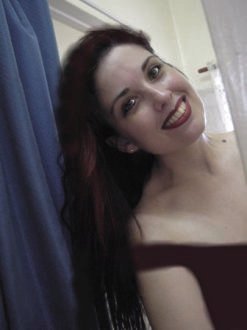
|
Coral is the author of over 50 books of poetry, prose poetry, fiction, artwork and digital photography. Born in 1965 she was raised under disadvantaged circumstances in the working class suburb of Liverpool in Sydney's outer west. Coral became concerned with issues of social justice and spirituality from an early age. Coral became an ethical vegan and an animal rights advocate who has since spent much of her life working voluntarily on behalf of animals and the environment, both as an individual and for various non-profit organisations. She is also the Executive Editor and Publisher of Thylazine: an electronic journal featuring articles, interviews and reviews of the recent work of Australian writers and artists. Coral Hull's complete works are now available from Artesian Productions (Darwin, Australia). Coral holds a Doctor of Creative Arts Degree (Creative Writing Major) from the University of Wollongong. An extensive biography, list of publications, festivals, interviews, articles and reviews are online. Coral is The Director of The Thylazine Foundation: Arts, Ethics and Literature. Coral Hull's work is in the public domain for non-commercial use under the Creative Commons License. |
[Above] Coral Hull, Elliot Hotel, Elliot, Northern Territory, Australia. (Photo by Coral Hull, 2001)
I Next I
Back I
Exit I
Thylazine No.11 (June, 2006) |



